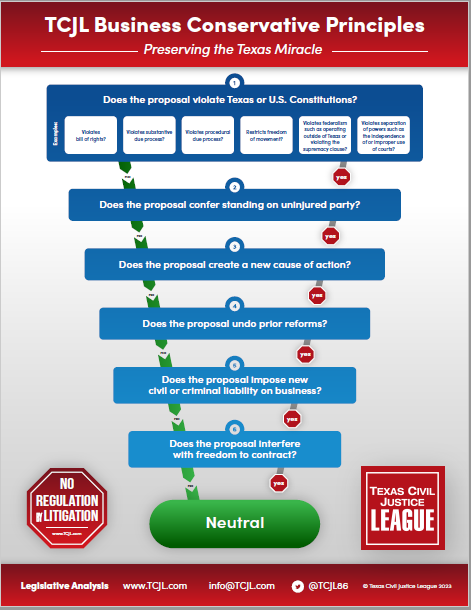 Earlier today SCOTX denied review of a Houston [1st] Court of Appeals decision allowing a medical malpractice claim against two physicians and their employer hospital to go forward. Jerry M. Keepers, M.D., Eric Kay-Fung Chan, M.D., and Vista Community Medical Center, d/b/a Surgery Specialty Hospitals of America v. Michael Smith and Valerie Smith(No. 01-20-00463-CV) arose from an anoxic brain injury suffered by a patient following a lumbar facet block procedure performed by the physicians. Plaintiffs brought suit, alleging that the physicians and the hospital were negligent in a number of ways and timely served an expert report under Chapter 74, CPRC. The defendant providers moved to dismiss on the basis of the inadequacy of the report with respect to the standard of care, breach, and causation elements. The trial court denied the motion, and the court of appeals affirmed.
Earlier today SCOTX denied review of a Houston [1st] Court of Appeals decision allowing a medical malpractice claim against two physicians and their employer hospital to go forward. Jerry M. Keepers, M.D., Eric Kay-Fung Chan, M.D., and Vista Community Medical Center, d/b/a Surgery Specialty Hospitals of America v. Michael Smith and Valerie Smith(No. 01-20-00463-CV) arose from an anoxic brain injury suffered by a patient following a lumbar facet block procedure performed by the physicians. Plaintiffs brought suit, alleging that the physicians and the hospital were negligent in a number of ways and timely served an expert report under Chapter 74, CPRC. The defendant providers moved to dismiss on the basis of the inadequacy of the report with respect to the standard of care, breach, and causation elements. The trial court denied the motion, and the court of appeals affirmed.
The court of appeals considered whether the trial court abused its discretion, meaning that it acted arbitrarily or unreasonably without reference to guiding rules or principles. In Chapter 74 cases, a trial court may only dismiss the action “if it appears to the court, after [a] hearing, that the report does not represent an objective good faith effort to comply with [TMLA’s] definition of an expert report.” A report represents an “objective good faith effort” if it informs the defendant provider of the specific conduct that the plaintiff questions or complains of, and (2) provides a basis on which the trial court may determine that the claim has merit (citations omitted). A trial court’s determination is confined to the four corners of the report and the expert’s CV, and courts must view the report in its entirety rather than isolating specific parts of the report in determining its adequacy (citations omitted). The same report, even if identical, may be adequate as to multiple providers, including for purposes of showing vicarious liability of a provider’s employer.
The court of appeals’ opinion ran to more than 60 pages, much of which involved a repetition of Plaintiffs’ expert report as to each physician and the hospital. In each case the court of appeals determined that the report met the “objective good faith” test because it adequately established the standard of care, demonstrated what the providers could have done differently to avoid or mitigate the patient’s injury, and sufficiently indicated both elements of substantial causation, but-for causation and foreseeability. The court also found that based on the expert’s CV, which detailed his credentials and experience as an anesthesiologist, qualified him to make the report.
If there was a problem in the court’s analysis, however, it lay in the causation determination. The patient had significant health conditions, including obesity, diabetes, hypertension, and a history of heart problems. He had previously undergone numerous procedures for back pain, including a lumbar facet block, performed by the same physician, all without incident. Plaintiffs’ expert opined that the providers breached the standard of care, among other things, when they failed to perform certain pre-operative tests and consult with the patient’s cardiologist and internist. According to the report, if they had done so, they wouldn’t have done the surgery at all, or at the very least they would have administered a local rather than general anesthetic. This seems problematic to us. Physicians make mistakes just like everybody else, but Plaintiffs’ expert in this case asserted that their decision to perform the procedure caused the harm. If that’s the case, every instance in which elective surgery has a bad outcome could generate a lawsuit on the theory that the cardinal error was doing it in the first place.
To be sure, Plaintiffs’ expert opined about several other acts or omissions that he believes fell short of the standard of care, some of which (such as the combination of anesthetics) could have caused the harm. Nevertheless, there is something troubling about the premise of his report that the court of appeals let pass without comment. At the same time, the court of appeals properly pointed out that trial and appellate courts, when deciding on the adequacy of an expert report under Chapter 74, are limited to the four corners of the report and whether it represents a “good faith effort to comply.” But if the case ever gets to trial, showing “but for” causation could be a problem.











